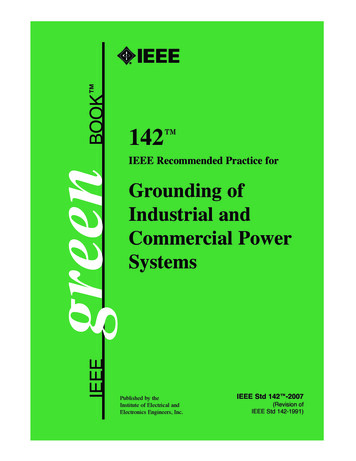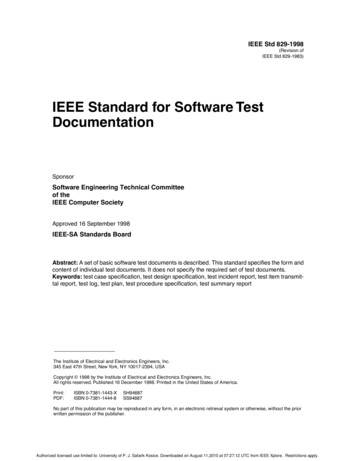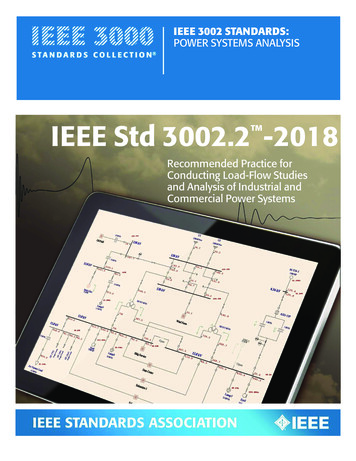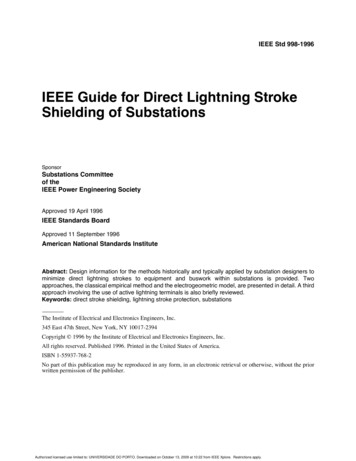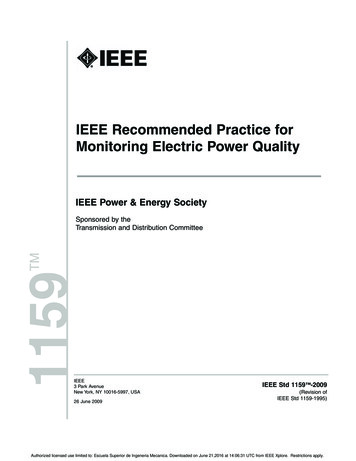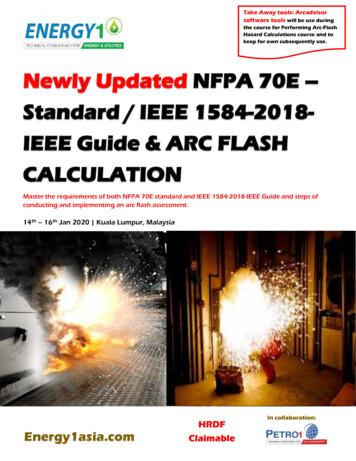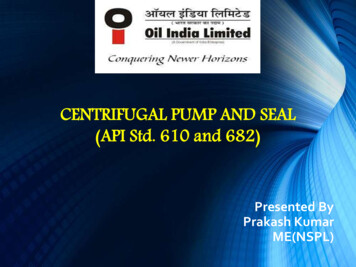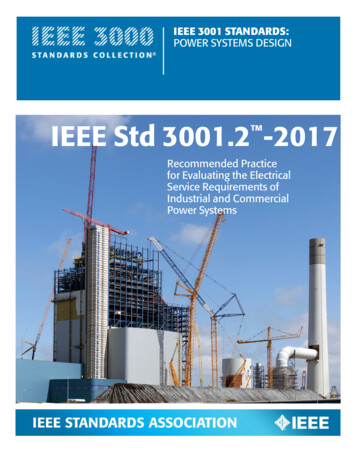
Transcription
IEEE 3001 STANDARDS:POWER SYSTEMS DESIGNIEEE Std 3001.2 -2017 Recommended Practicefor Evaluating the ElectricalService Requirements ofIndustrial and CommercialPower Systems
IEEE Std 3001.2 -2017IEEE Recommended Practice forEvaluating the Electrical ServiceRequirements of Industrial andCommercial Power SystemsSponsorTechnical Books Coordinating Committeeof theIEEE Industry Applications SocietyApproved 6 December 2017IEEE-SA Standards Board
Abstract: Commercial, institutional, and industrial design of electrical services, interconnecting witha utility distribution or transmission system is explored. The electrical system information neededby the designer concerning the utility’s system characteristics, and the electrical load informationneeded by the utility to design a satisfactory electrical interface between the serving utility and thepremise electrical distribution system is considered.Keywords: electric rates, IEEE 3001.2, service, service entrance, substation, utility metering, utilitybilling, vaultsThe Institute of Electrical and Electronics Engineers, Inc.3 Park Avenue, New York, NY 10016-5997, USACopyright 2017 by The Institute of Electrical and Electronics Engineers, Inc.All rights reserved. Published 10 May 2018. Printed in the United States of America.IEEE is a registered trademark in the U.S. Patent & Trademark Office, owned by The Institute of Electrical and Electronics Engineers,Incorporated.PDF:Print:ISBN 978-1-5044-4513-9ISBN 978-1-5044-4514-6STD22890STDPD22890IEEE prohibits discrimination, harassment, and bullying.For more information, visit http:// www .ieee .org/ web/ aboutus/ whatis/ policies/ p9 -26 .html.No part of this publication may be reproduced in any form, in an electronic retrieval system or otherwise, without the prior written permissionof the publisher.
Important Notices and Disclaimers Concerning IEEE Standards DocumentsIEEE documents are made available for use subject to important notices and legal disclaimers. These noticesand disclaimers, or a reference to this page, appear in all standards and may be found under the heading“Important Notice” or “Important Notices and Disclaimers Concerning IEEE Standards Documents.”Notice and Disclaimer of Liability Concerning the Use of IEEE StandardsDocumentsIEEE Standards documents (standards, recommended practices, and guides), both full-use and trial-use,are developed within IEEE Societies and the Standards Coordinating Committees of the IEEE StandardsAssociation (“IEEE-SA”) Standards Board. IEEE (“the Institute”) develops its standards through a consensusdevelopment process, approved by the American National Standards Institute (“ANSI”), which bringstogether volunteers representing varied viewpoints and interests to achieve the final product. Volunteersare not necessarily members of the Institute and participate without compensation from IEEE. While IEEEadministers the process and establishes rules to promote fairness in the consensus development process, IEEEdoes not independently evaluate, test, or verify the accuracy of any of the information or the soundness of anyjudgments contained in its standards.IEEE does not warrant or represent the accuracy or content of the material contained in its standards, andexpressly disclaims all warranties (express, implied and statutory) not included in this or any other documentrelating to the standard, including, but not limited to, the warranties of: merchantability; fitness for a particularpurpose; non-infringement; and quality, accuracy, effectiveness, currency, or completeness of material. Inaddition, IEEE disclaims any and all conditions relating to: results; and workmanlike effort. IEEE standardsdocuments are supplied “AS IS” and “WITH ALL FAULTS.”Use of an IEEE standard is wholly voluntary. The existence of an IEEE standard does not imply that thereare no other ways to produce, test, measure, purchase, market, or provide other goods and services related tothe scope of the IEEE standard. Furthermore, the viewpoint expressed at the time a standard is approved andissued is subject to change brought about through developments in the state of the art and comments receivedfrom users of the standard.In publishing and making its standards available, IEEE is not suggesting or rendering professional or otherservices for, or on behalf of, any person or entity nor is IEEE undertaking to perform any duty owed by anyother person or entity to another. Any person utilizing any IEEE Standards document, should rely upon his orher own independent judgment in the exercise of reasonable care in any given circumstances or, as appropriate,seek the advice of a competent professional in determining the appropriateness of a given IEEE standard.IN NO EVENT SHALL IEEE BE LIABLE FOR ANY DIRECT, INDIRECT, INCIDENTAL, SPECIAL,EXEMPLARY, OR CONSEQUENTIAL DAMAGES (INCLUDING, BUT NOT LIMITED TO:PROCUREMENT OF SUBSTITUTE GOODS OR SERVICES; LOSS OF USE, DATA, OR PROFITS;OR BUSINESS INTERRUPTION) HOWEVER CAUSED AND ON ANY THEORY OF LIABILITY,WHETHER IN CONTRACT, STRICT LIABILITY, OR TORT (INCLUDING NEGLIGENCE OROTHERWISE) ARISING IN ANY WAY OUT OF THE PUBLICATION, USE OF, OR RELIANCEUPON ANY STANDARD, EVEN IF ADVISED OF THE POSSIBILITY OF SUCH DAMAGE ANDREGARDLESS OF WHETHER SUCH DAMAGE WAS FORESEEABLE.TranslationsThe IEEE consensus development process involves the review of documents in English only. In the event thatan IEEE standard is translated, only the English version published by IEEE should be considered the approvedIEEE standard.3Copyright 2017 IEEE. All rights reserved.
Official statementsA statement, written or oral, that is not processed in accordance with the IEEE-SA Standards Board OperationsManual shall not be considered or inferred to be the official position of IEEE or any of its committees and shallnot be considered to be, or be relied upon as, a formal position of IEEE. At lectures, symposia, seminars, oreducational courses, an individual presenting information on IEEE standards shall make it clear that his or herviews should be considered the personal views of that individual rather than the formal position of IEEE.Comments on standardsComments for revision of IEEE Standards documents are welcome from any interested party, regardlessof membership affiliation with IEEE. However, IEEE does not provide consulting information or advicepertaining to IEEE Standards documents. Suggestions for changes in documents should be in the form of aproposed change of text, together with appropriate supporting comments. Since IEEE standards represent aconsensus of concerned interests, it is important that any responses to comments and questions also receivethe concurrence of a balance of interests. For this reason, IEEE and the members of its societies and StandardsCoordinating Committees are not able to provide an instant response to comments or questions except inthose cases where the matter has previously been addressed. For the same reason, IEEE does not respond tointerpretation requests. Any person who would like to participate in revisions to an IEEE standard is welcometo join the relevant IEEE working group.Comments on standards should be submitted to the following address:Secretary, IEEE-SA Standards Board445 Hoes LanePiscataway, NJ 08854 USALaws and regulationsUsers of IEEE Standards documents should consult all applicable laws and regulations. Compliance withthe provisions of any IEEE Standards document does not imply compliance to any applicable regulatoryrequirements. Implementers of the standard are responsible for observing or referring to the applicableregulatory requirements. IEEE does not, by the publication of its standards, intend to urge action that is not incompliance with applicable laws, and these documents may not be construed as doing so.CopyrightsIEEE draft and approved standards are copyrighted by IEEE under US and international copyright laws. Theyare made available by IEEE and are adopted for a wide variety of both public and private uses. These includeboth use, by reference, in laws and regulations, and use in private self-regulation, standardization, and thepromotion of engineering practices and methods. By making these documents available for use and adoptionby public authorities and private users, IEEE does not waive any rights in copyright to the documents.PhotocopiesSubject to payment of the appropriate fee, IEEE will grant users a limited, non-exclusive license to photocopyportions of any individual standard for company or organizational internal use or individual, non-commercialuse only. To arrange for payment of licensing fees, please contact Copyright Clearance Center, CustomerService, 222 Rosewood Drive, Danvers, MA 01923 USA; 1 978 750 8400. Permission to photocopy portionsof any individual standard for educational classroom use can also be obtained through the Copyright ClearanceCenter.4Copyright 2017 IEEE. All rights reserved.
Updating of IEEE Standards documentsUsers of IEEE Standards documents should be aware that these documents may be superseded at any timeby the issuance of new editions or may be amended from time to time through the issuance of amendments,corrigenda, or errata. An official IEEE document at any point in time consists of the current edition of thedocument together with any amendments, corrigenda, or errata then in effect.Every IEEE standard is subjected to review at least every 10 years. When a document is more than 10 years oldand has not undergone a revision process, it is reasonable to conclude that its contents, although still of somevalue, do not wholly reflect the present state of the art. Users are cautioned to check to determine that they havethe latest edition of any IEEE standard.In order to determine whether a given document is the current edition and whether it has been amended throughthe issuance of amendments, corrigenda, or errata, visit the IEEE-SA Website at http:// ieeexplore .ieee .org/ xpl/ standards .jsp or contact IEEE at the address listed previously. For more information about the IEEE-SA orIEEE’s standards development process, visit the IEEE-SA Website at http:// standards .ieee .org.ErrataErrata, if any, for all IEEE standards can be accessed on the IEEE-SA Website at the following URL: http:// standards .ieee .org/ findstds/ errata/ index .html. Users are encouraged to check this URL for errata periodically.PatentsAttention is called to the possibility that implementation of this standard may require use of subject mattercovered by patent rights. By publication of this standard, no position is taken by the IEEE with respect to theexistence or validity of any patent rights in connection therewith. If a patent holder or patent applicant hasfiled a statement of assurance via an Accepted Letter of Assurance, then the statement is listed on the IEEESA Website at http:// standards .ieee .org/ about/ sasb/ patcom/ patents .html. Letters of Assurance may indicatewhether the Submitter is willing or unwilling to grant licenses under patent rights without compensationor under reasonable rates, with reasonable terms and conditions that are demonstrably free of any unfairdiscrimination to applicants desiring to obtain such licenses.Essential Patent Claims may exist for which a Letter of Assurance has not been received. The IEEE is notresponsible for identifying Essential Patent Claims for which a license may be required, for conducting inquiriesinto the legal validity or scope of Patents Claims, or determining whether any licensing terms or conditionsprovided in connection with submission of a Letter of Assurance, if any, or in any licensing agreements arereasonable or non-discriminatory. Users of this standard are expressly advised that determination of thevalidity of any patent rights, and the risk of infringement of such rights, is entirely their own responsibility.Further information may be obtained from the IEEE Standards Association.5Copyright 2017 IEEE. All rights reserved.
ParticipantsAt the time this IEEE recommended practice was completed, the Power System Design Editorial WorkingGroup had the following membership:Gary H. Fox, ChairRobert ArnoNeal DowlingNehad El-SherifBarry HornbergerDuane LeschertDennis K. NeitzelAmol PathakMarcelo ValdesThe following members of the individual balloting committee voted on this recommended practice. Ballotersmay have voted for approval, disapproval, or abstention.Frank BascianoSirak BelaynehFrederick BrockhurstGustavo BrunelloWilliam ByrdPaul CardinalKurt ClementeGlenn DavisDavide De LucaNeal DowlingGary FoxRandall GrovesChris HeronWerner HoelzlRobert HoeraufLaszlo KadarGael KennedyYuri KhersonskyJim KulchiskySaumen KunduMarc LacroixBenjamin LanzWei-Jen LeeDuane LeschertJohn Mcalhaney Jr.William McBrideJohn McClellandMassimo MitoloDaleep MohlaJerry MurphyDaniel NeeserDennis K. NeitzelMichael NewmanJoe NimsGearold O. H. EidhinT. W. OlsenLorraine PaddenAntony ParsonsJim PhillipsLouie PowellIulian ProfirMoises RamosCharles RogersVincent SaporitaBartien SayogoTed SchoenbergRobert SeitzNikunj ShahJeremy SmithJerry SmithGary SmullinWayne StecK. StumpDavid TepenMarcelo ValdesKenneth WhiteJames WolfeJian YuWhen the IEEE-SA Standards Board approved this recommended practice on 6 December 2017, it had thefollowing membership:Jean-Philippe Faure, ChairGary Hoffman, Vice ChairJohn D. Kulick, Past ChairKonstantinos Karachalios, SecretaryChuck AdamsMasayuki AriyoshiTed BurseStephen DukesDoug EdwardsJ. Travis GriffithMichael JanezicThomas KoshyJoseph L. Koepfinger*Kevin LuDaleep MohlaDamir NovoselRonald C. PetersenAnnette D. Reilly*Member Emeritus6Copyright 2017 IEEE. All rights reserved.Robby RobsonDorothy StanleyAdrian StephensMehmet UlemaPhil WennblomHoward WolfmanYu Yuan
IntroductionThis introduction is not part of IEEE Std 3001.2 -2017, IEEE Recommended Practice for Evaluating the ElectricalService Requirements of Industrial and Commercial Power Systems.IEEE 3000 Standards Collection This recommended practice was developed by the Technical Books Coordinating Committee of the Industrialand Commercial Power Systems Department of the Industry Applications Society, as part of a project torepackage IEEE’s popular series of IEEE Color Books . The goal of this project is to speed up the revisionprocess, eliminate duplicate material, and facilitate use of modern publishing and distribution technologies.When this project is completed, the technical material included in the 13 Color Books will be included in aseries of new standards—the most significant of which will be a new book, IEEE Standard 3000 , IEEERecommended Practice for the Engineering of Industrial and Commercial Power Systems. The new standardwill cover the fundamentals of planning, design, analysis, construction, installation, start-up, operation, andmaintenance of electrical systems in industrial and commercial facilities. Approximately 60 additional dotstandards, organized into the following categories, will provide in-depth treatment of many of the topicsintroduced by IEEE Std 3000 :—Power Systems Design (3001 series)—Power Systems Analysis (3002 series)—Power Systems Grounding (3003 series)—Protection and Coordination (3004 series)—Emergency, Standby Power, and Energy Management Systems (3005 series)—Power Systems Reliability (3006 series)—Power Systems Maintenance, Operations, and Safety (3007 series)In many cases, the material in a “dot” standard comes from a particular chapter of a particular color book. Inother cases, material from several color books has been combined into a new “dot” standard.The material in this recommended practice largely comes from Chapter 2 and Chapter 15 of the IEEE RedBook , IEEE Std 141 -1993, Recommended Practice for Electric Power Distribution in Industrial Plants,and Chapter 4 and Chapter 7 of the IEEE Gray Book , IEEE Std 241 -1990.IEEE Std 3001.2This publication provides a recommended practice for the electrical design of commercial and industrialfacilities. It is likely to be of greatest value to the power-oriented engineer with limited commercial or industrialplant experience. It can also be an aid to all engineers responsible for the electrical design of commercial andindustrial facilities. However, it is not intended as a replacement for the many excellent engineering texts andhandbooks commonly in use, nor is it detailed enough to be a design manual. It should be considered a guideand general reference on electrical design for commercial and industrial facilities.Tables, charts, and other information that have been extracted from codes, standards, and other technicalliterature are included in this publication. Their inclusion is for illustrative purposes; where technical accuracyis important, the latest version of the referenced document should be consulted to assure use of complete, upto-date, and accurate information.7Copyright 2017 IEEE. All rights reserved.
Contents1. Scope 102. Normative references 103. Common relationships with electric utilities 114. Planning for utility service 114.1 Introduction 114.2 Utility/designer communication 124.3 Service availability 124.4 Facility load information 154.5 Information from the utility 164.6 Interrelated utility and project factors that influence design 195. Electric rates 205.1 Demand and fixed charges 205.2 Energy and variable charges 205.3 Power factor credits and penalties 216. Electric utility metering and billing 216.1 Introduction 216.2 Metering by type of premises 226.3 Metering by service voltage characteristics 226.4 Meter location 226.5 Meter mounting, control, and associated equipment 236.6 Metering equipment guidelines and types 246.7 Metering for energy conservation 276.8 Utility billing 277. Distribution circuit arrangements 297.1 Introduction 297.2 Network systems 297.3 Small commercial buildings 297.4 Medium and large commercial buildings 297.5 Large industrial facilities 307.6 Medium-voltage distribution 307.7 Multiple services 307.8 Multiple tenants 308. Incoming lines and service laterals 308.1 Introduction 308.2 Overhead service 318.3 Underground service 338.4 Service entrance conductors within a building 349. Service entrance installations 359.1 Introduction 359.2 Number of services 359.3 Physical arrangement 369.4 Service design considerations 369.5 Medium-voltage services 389.6 Vaults and pads for service equipment 399.7 Network vaults for high-rise buildings 418Copyright 2017 IEEE. All rights reserved.
9.8 Service rooms and electrical closets 4410. Large services 4510.1 Introduction 4510.2 Purpose 4510.3 Substation justification 4610.4 Development stages 4610.5 Project participants 4710.6 Planning stage 4710.7 Design stage 5810.8 Construction stage 66Annex A (informative) Bibliography 709Copyright 2017 IEEE. All rights reserved.
IEEE Recommended Practice forEvaluating the Electrical ServiceRequirements of Industrial andCommercial Power Systems1. ScopeThis recommended practice explores commercial, institutional, and industrial design of electrical services,interconnecting with a utility distribution or transmission system. Close coordination between the facilityelectrical designer and the serving utility are critical for a successful service connection. This recommendedpractice considers the electrical system information needed by the designer concerning the utility’s systemcharacteristics and the electrical load information needed by the utility to design a satisfactory electricalinterface between the serving utility and the premise electrical distribution system. It describes various waysto take power from the serving utility. It also covers the specific requirements for utility metering on serviceentrance equipment, as well as service equipment rooms, vaults, and pads.2. Normative referencesThe following referenced documents are indispensable for the application of this document (i.e., they mustbe understood and used, so each referenced document is cited in text and its relationship to this document isexplained). For dated references, only the edition cited applies. For undated references, the latest edition of thereferenced document (including any amendments or corrigenda) applies.Accredited Standards Committee C2 , National Electrical Safety Code (NESC ).IEC 61936-1-Ed.1.0, Power installations exceeding 1 kV ac—Part 1: Common Rules.1IEEE Std 80 , IEEE Guide for Safety in AC Substation Grounding.2,3IEEE Std 142 , IEEE Recommended Practice for Grounding of Industrial and Commercial Power Systems(IEEE Green Book ).IEEE Std 693 , IEEE Recommended Practice for Seismic Design of Substations.IEC publications are available from the International Electrotechnical Commission (http:// www .iec .ch) and the American NationalStandards Institute (http:// www .ansi .org/ ).2The IEEE standards or products referred to in Clause 2 are trademarks owned by The Institute of Electrical and Electronics Engineers,Incorporated.3IEEE publications are available from The Institute of Electrical and Electronics Engineers (http:// standards .ieee .org/ ).110Copyright 2017 IEEE. All rights reserved.
IEEE Std 3001.2-2017IEEE Recommended Practice for Evaluating the Electrical ServiceRequirements of Industrial and Commercial Power SystemsIEEE Std 979 , IEEE Guide for Substation Fire Protection.IEEE Std 980 , IEEE Guide for Containment and Control of Oil Spills in Substations.IEEE Std 998 , IEEE Guide for Direct Lightning Stroke Shielding of Substations.IEEE Std 1127 , IEEE Guide for the Design, Construction, and Operation of Electric Power Substations forCommunity Acceptance and Environmental Compatibility.IEEE Std 1402 , IEEE Guide for Electric Power Substation Physical and Electronic Security.NFPA 70 , National Electrical Code (NEC ).43. Common relationships with electric utilitiesThe most common relationship that exists between the industrial or commercial facility and a connectingelectric utility is that of a seller and buyer. That is, the electric utility supplies electric energy to the facilitybased on a rate typically regulated by a state agency as the utility will typically have a monopoly over serving agiven geographic area. Considering this, the industrial or commercial user may be referred to as the customer.The relationship between a utility and its customer has become more complex based on the followingdevelopments.—Wholesale power agreements that allow a user to purchase energy from entities other than theconnecting utility. The connecting utility is not the direct seller of energy. However, the connectingutility will usually still be compensated for the use of their distribution system through wheelingcharges that are added onto the user’s monthly energy invoice.—Community Choice Aggregation programs that allow users within the geographic boundaries of theprogram to secure alternative energy supply agreements by working in aggregate, typically through acity or county agency.—The capability to generate power onsite, typcially through cogeneration or renewable energy sourcessuch as wind turbines or photovoltaic panels. Diesel engine or gas turbine sources may be used. Theonsite generation may simply reduce the overall facility demand, or the user may be permitted toexport power when the user’s onsite source capacity is greater than the user’s own load demand. Theutility should be consulted to determine whether they are willing to accept any exported pow
Use of an IEEE standard is wholly voluntary. The existence of an IEEE standard does not imply that there are no other ways to produce, test, measure, purchase, market, or provide other goods and services related to the scope of the IEEE standard. Furthermore, the viewpoint expresse


